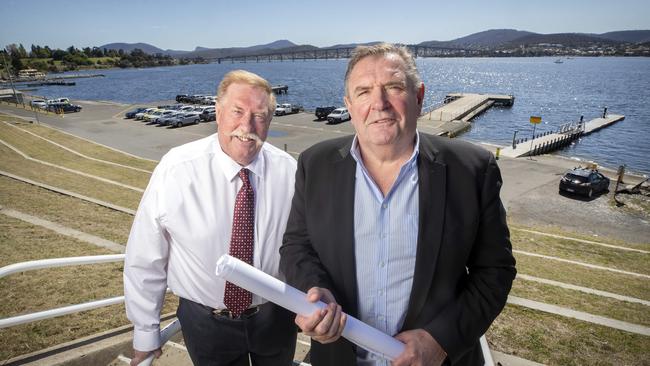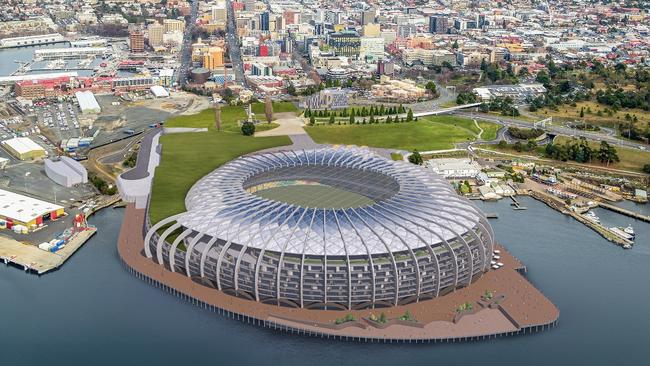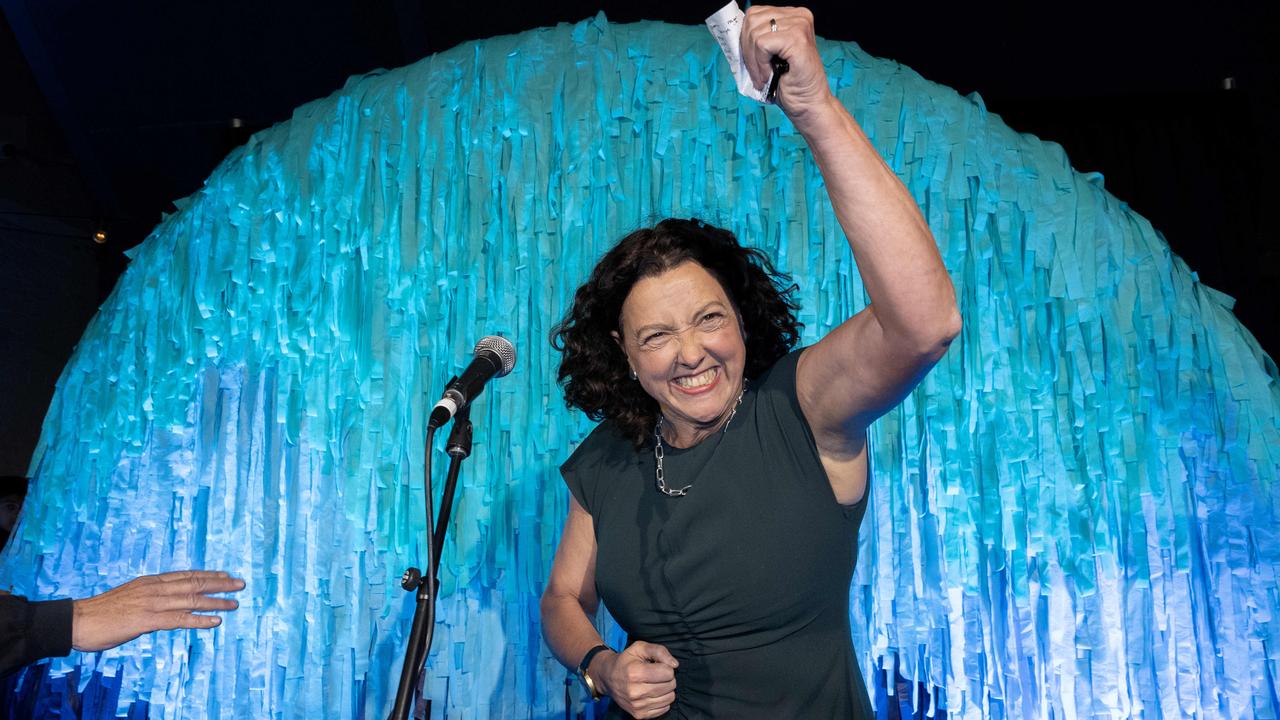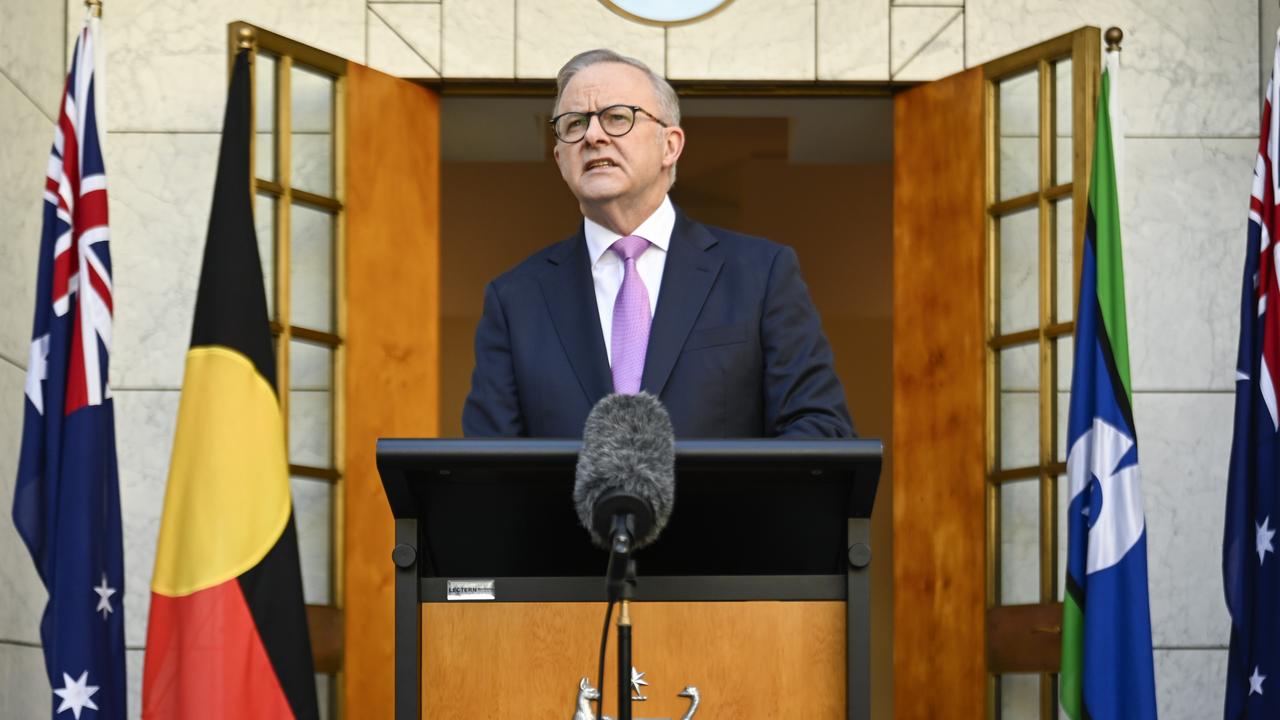Rethink Hobart AFL stadium to save it, Premier Jeremy Rockliff warned
Tasmanian business and community leaders have warned Premier Jeremy Rockliff to rethink his Hobart AFL stadium or risk its failure, as key crossbenchers vowed to vote down the $1bn-plus project.

Tasmanian business and community leaders have warned Premier Jeremy Rockliff to rethink his Hobart AFL stadium or risk its failure, as key crossbenchers vowed to vote down the $1bn-plus project.
The stadium – the AFL’s condition on the Tasmania Devils entering the national competition – is believed by key figures in business, political and community circles to be heading for disaster.
There are concerns the project is under-budgeted, cannot be squeezed into the current Macquarie Point site, faces long heritage-related delays and is run by a bureaucracy lacking sufficient expertise.
It appears set for defeat in state parliament. Two key crossbenchers – Jacqui Lambie Network MP Rebekah Pentland and independent Craig Garland – told The Weekend Australian they could not vote for a Hobart stadium.
Given the known positions of other MPs, their stance means the stadium cannot pass unless Labor backflips on its pre-election opposition.
Michael Bailey, chief executive of the Tasmanian Chamber of Commerce and Industry, and Hobart Lord Mayor Anna Reynolds, told The Weekend Australian it was time to consider dumping the current plan in favour of an alternative dubbed “Stadium 2.0”. Unlike the government’s plan, the $2.2bn Stadium 2.0 – proposed for nearby waterfront land by an experienced private consortium – is well advanced in design and financing and has council backing to submit a development application.

Its larger envelope, involving reclaiming land 210m out into the River Derwent from Regatta Point, allows for major hotels, 456 apartments, 310 affordable housing units, 5240 car parks and a private hospital.
These profitable “extras” are seen by the private sector as vital to secure income streams to fund a loss-making stadium.
This is especially so after Mr Rockliff “capped” state taxpayer expenditure on his proposed stadium – independently estimated to cost $1.1bn-$1.4bn – at just $375m.
The federal government has pledged $240m for redevelopment of Macquarie Point but it is unclear how much of this will be spent on the stadium.
With the AFL contributing only $15m, Mr Rockliff has said any shortfall, which under the contract must be met by taxpayers, will come from private investors.
“The private sector is unlikely to invest in a stadium per se because a stadium itself doesn’t really reap a return,” Mr Bailey said.
“It’s the stuff around a stadium that is revenue-generating so to us that’s why the Stadium 2.0 public-private partnership makes a lot more sense.
“We can’t see how you can cap the build of the actual stadium and expect the private sector to come in. The business case the government has presented essentially has a ‘return’ of losing a dollar for every 50c put into it.
“It doesn’t make financial sense. Hotels and other things around it do make sense.”
Mr Bailey said there were “mounting issues” with the Macquarie Point site, including this week’s heritage listing of a goods shed that must be moved to make way for the stadium.
“That will just delay the project but it will delay it significantly,” he said. “These sorts of delays can last years.

“The 2.0 model seems to have a much easier, more logical pathway. It has the support of the Hobart City Council, the RSL, the Regatta Grounds and a number of local businesses who would be impacted by Stadium 1.0.”
He said 2.0 – led by businessman Dean Coleman, experienced with private-public partnerships and stadium developments, and former Labor premier Paul Lennon – appeared to have more support than Stadium 1.0.
“If we’re going to have an AFL team we need to have a new stadium,” Mr Bailey said. “The question now is how do we get the stadium that Tasmanians will celebrate in 50 years time, rather than be ashamed of – and do it in a way that least exposes the taxpayer to cost overruns.
“There needs to be a rethink. From the business community’s point of view, Stadium 1.0 seems to be a difficult one when it comes to the public-private model we know works best. The sooner there’s a serious look at it (2.0) the better.”
Mr Bailey suggested the Macquarie Point Development Corporation may not be the best body to develop the stadium. “Businesses that specialise in these kinds of very difficult projects are always best to run them,” he said.
Ms Reynolds backed the rethink calls, warning that the current proposal was “creating a nightmare for everyone” and was unlikely to lead to “a sensible outcome for the city”.
“As time goes on, it will become obvious that Macquarie Point (1.0) is not a great location for this size of building,” she said.
“It’s created a lot of political upheaval in the state and that’s likely to continue because the good planning work wasn’t done from the beginning. It was very much an imposed idea.
“The council has been more impressed by the approach of the Stadium 2.0 folks.
“Stadium 2.0 definitely has more things going for it.”
Ms Reynolds said she personally believed the government should also consider a major refurbishment of Bellerive Oval as an alternative.
Master Builders Association chief executive David Clerk said any stadium development needed to include hotels, carparks or apartments to secure additional private capital.
“The Premier should be looking at all options on the table at this stage,” he said.
JLN MP Rebekah Pentland said she could not vote for a project opposed by most people in her electorate of Bass. “I am here to represent them,” she said.
She backed fellow JLN MP Andrew Jenner and party founder Jacqui Lambie in urging consideration of Launceston’s York Park stadium – already being upgraded to host Devils games – as the team’s main ground.
York Park was also backed by Mr Garland. “Hobart is not central and a new stadium in Hobart will exclude Northwest coasters by being cost prohibitive (for them to travel to games),” he said. “Launceston already has the facilities.”
Labor leader Dean Winter said his party was yet to form a post-election position on the stadium, which had become “a huge mess”.
“The more we find out about Jeremy Rockliff’s stadium, the more doubt is raised about whether it’s even possible for him to build it within the tight conditions he’s signed the state up to,” he said.
Mr Coleman said his project was viable with state funding “close to” the Premier’s $375m cap and could meet AFL deadlines – but only if the state gave the green light by June this year.
He believed it was the only viable project. “Our project stacks up because it is a multipurpose, community-based precinct,” he said.
“So it’s not reliant on one stream of revenue and we have a number of private investment components that inject a lot of capital into funding the stadium.”
Under the AFL deal with the state, the stadium – yet to be designed – must clear the planning process by June 30, 2025, and be 60 per cent built by October 31, 2027. Penalties of $4.5m a year apply for late compliance.
Mr Rockliff was holding firm on the current proposal. “The Tasmanian government is not contemplating involvement in any alternate proposals,” a government spokesman said.
The AFL is understood to be leaving it up to the Tasmanian government as to how it delivers the stadium, which the contract states must be fully roofed and have 23,000 seats. It declined to comment on 2.0.
Macquarie Point Development Corporation defended Stadium 1.0 as also capable of attracting private investment.
“Our work to remediate and prepare Mac Point for redevelopment has always been undertaken with the intent of taking land to market to encourage appropriate investment by the private sector,” a spokeswoman said.







To join the conversation, please log in. Don't have an account? Register
Join the conversation, you are commenting as Logout